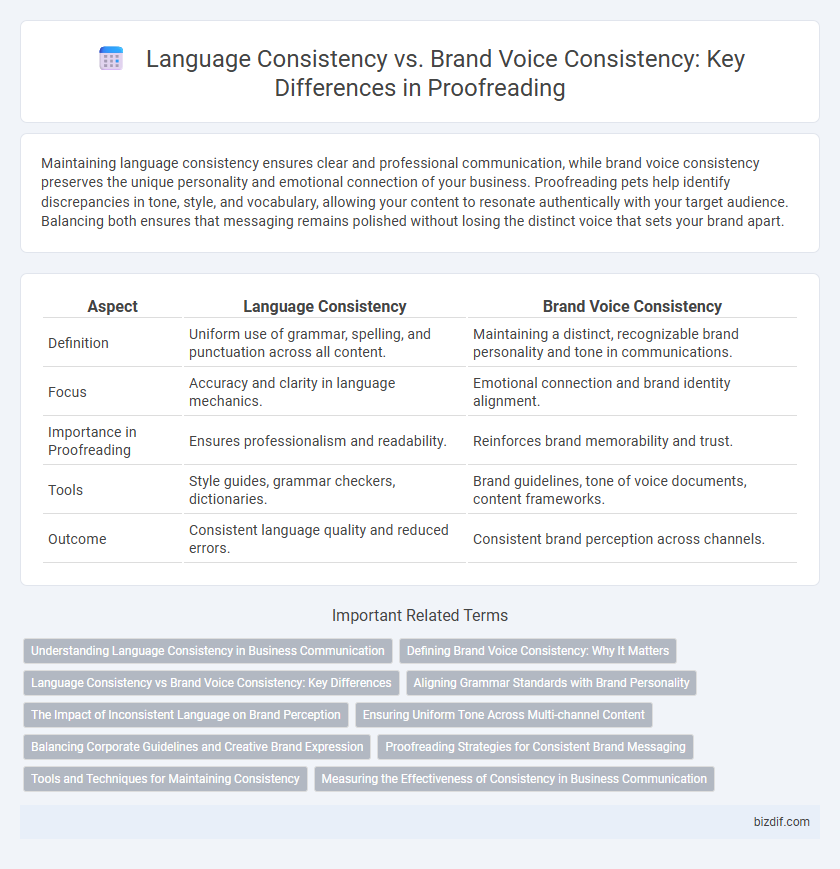Maintaining language consistency ensures clear and professional communication, while brand voice consistency preserves the unique personality and emotional connection of your business. Proofreading pets help identify discrepancies in tone, style, and vocabulary, allowing your content to resonate authentically with your target audience. Balancing both ensures that messaging remains polished without losing the distinct voice that sets your brand apart.
Table of Comparison
| Aspect | Language Consistency | Brand Voice Consistency |
|---|---|---|
| Definition | Uniform use of grammar, spelling, and punctuation across all content. | Maintaining a distinct, recognizable brand personality and tone in communications. |
| Focus | Accuracy and clarity in language mechanics. | Emotional connection and brand identity alignment. |
| Importance in Proofreading | Ensures professionalism and readability. | Reinforces brand memorability and trust. |
| Tools | Style guides, grammar checkers, dictionaries. | Brand guidelines, tone of voice documents, content frameworks. |
| Outcome | Consistent language quality and reduced errors. | Consistent brand perception across channels. |
Understanding Language Consistency in Business Communication
Language consistency in business communication ensures uniform grammar, spelling, and terminology usage across all company materials, reinforcing clarity and professionalism. This practice reduces misunderstandings and enhances the audience's ability to recognize and trust the brand message. Maintaining consistent language supports brand voice consistency by providing a stable foundation upon which a distinctive and recognizable brand tone can be built.
Defining Brand Voice Consistency: Why It Matters
Brand voice consistency ensures that every piece of communication reflects a unified tone, style, and personality aligned with the company's identity, enhancing brand recognition and trust. It establishes emotional connections with the target audience by creating a reliable and distinctive voice across all platforms and content types. Maintaining this consistency helps differentiate the brand in competitive markets while reinforcing core values and messaging clarity.
Language Consistency vs Brand Voice Consistency: Key Differences
Language consistency ensures uniform grammar, spelling, and punctuation across all content, creating clarity and professionalism. Brand voice consistency focuses on maintaining a distinctive tone and style that reflects the brand's identity and values. Balancing both aspects is crucial for cohesive communication that resonates with the target audience while preserving credibility.
Aligning Grammar Standards with Brand Personality
Aligning grammar standards with brand personality ensures language consistency that reinforces the brand voice effectively. Maintaining uniform grammar rules across all communications prevents confusion while reflecting the brand's unique tone and style. This balance between language precision and distinctive expression strengthens brand recognition and credibility.
The Impact of Inconsistent Language on Brand Perception
Inconsistent language across marketing materials can confuse audiences and weaken brand recognition, undermining the intended brand voice consistency. Discrepancies in tone, style, or terminology diminish consumer trust and reduce the perceived professionalism of the brand. Maintaining strict language consistency ensures a cohesive brand identity that strengthens customer loyalty and enhances overall brand perception.
Ensuring Uniform Tone Across Multi-channel Content
Ensuring language consistency across all content channels reinforces brand identity and strengthens audience trust. Maintaining a uniform tone while adapting to different platforms requires meticulous proofreading to align word choice, style, and messaging with the established brand voice. Proofreaders play a crucial role in detecting deviations and preserving coherence, enabling seamless multi-channel communication that resonates with the target audience.
Balancing Corporate Guidelines and Creative Brand Expression
Balancing language consistency and brand voice consistency requires adhering to corporate guidelines while allowing room for creative brand expression that resonates with target audiences. Maintaining uniform terminology, tone, and style enhances clarity and trust, whereas incorporating unique brand elements ensures distinctiveness and emotional connection. Effective proofreading bridges these aspects by fine-tuning content to align with both standardized language protocols and dynamic brand personality.
Proofreading Strategies for Consistent Brand Messaging
Effective proofreading strategies for maintaining consistent brand messaging involve ensuring language consistency by standardizing grammar, punctuation, and style according to a defined style guide. Brand voice consistency requires careful attention to tone, vocabulary, and phraseology that aligns with the brand's personality across all content. Implementing checklist-based reviews and leveraging automated tools designed for style and tone detection enhances accuracy in preserving both language and brand voice uniformity.
Tools and Techniques for Maintaining Consistency
Advanced proofreading tools like Grammarly and Hemingway Editor help maintain language consistency by flagging grammar, punctuation, and style errors across documents. Brand voice consistency can be ensured using customized style guides and AI-driven platforms such as Acrolinx, which analyze tone, terminology, and messaging alignment. Regular team training and collaborative editing software like Google Docs facilitate ongoing adherence to both language and brand voice standards.
Measuring the Effectiveness of Consistency in Business Communication
Measuring the effectiveness of language consistency versus brand voice consistency in business communication involves analyzing metrics such as customer engagement, brand recall, and message clarity. Tools like linguistic audits and brand voice guidelines help quantify adherence and identify variances impacting audience perception. Consistent language usage enhances professionalism while maintaining brand voice ensures emotional connection, both critical for strengthening brand identity and driving customer loyalty.
Language Consistency vs Brand Voice Consistency Infographic

 bizdif.com
bizdif.com